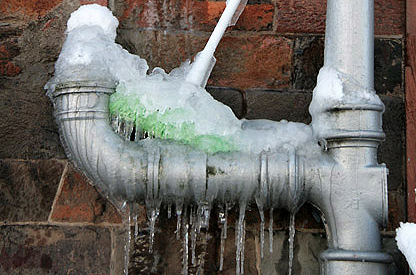Key Approaches for Preventing Frozen Pipes in Winter
Key Approaches for Preventing Frozen Pipes in Winter
Blog Article
Just about everyone will have their private perception on the subject of Preventing and dealing with frozen pipes.

Winter can wreak havoc on your pipes, particularly by freezing pipelines. Here's exactly how to avoid it from taking place and what to do if it does.
Intro
As temperatures decrease, the danger of icy pipelines increases, potentially causing expensive repairs and water damages. Comprehending how to avoid icy pipes is important for home owners in cool climates.
Avoidance Tips
Protecting vulnerable pipelines
Cover pipelines in insulation sleeves or make use of warm tape to shield them from freezing temperatures. Focus on pipes in unheated or outside areas of the home.
Heating methods
Keep interior areas appropriately warmed, specifically locations with plumbing. Open closet doors to permit cozy air to distribute around pipes under sinks.
Just how to recognize icy pipelines
Search for decreased water flow from taps, uncommon smells or noises from pipes, and noticeable frost on revealed pipes.
Long-Term Solutions
Structural changes
Consider rerouting pipes away from outside walls or unheated areas. Include additional insulation to attics, basements, and crawl spaces.
Upgrading insulation
Buy premium insulation for pipelines, attics, and walls. Correct insulation helps preserve regular temperature levels and decreases the threat of frozen pipes.
Shielding Outside Pipes
Yard hose pipes and outside faucets
Separate and drain pipes yard tubes prior to winter. Mount frost-proof faucets or cover exterior taps with insulated caps.
Understanding Frozen Pipes
What triggers pipelines to ice up?
Pipes ice up when subjected to temperatures below 32 ° F (0 ° C) for extended durations. As water inside the pipes freezes, it expands, putting pressure on the pipeline wall surfaces and potentially triggering them to break.
Risks and damages
Icy pipelines can result in water disturbances, building damage, and pricey fixings. Burst pipes can flooding homes and create comprehensive structural damage.
Signs of Frozen Pipes
Identifying frozen pipelines early can avoid them from rupturing.
What to Do If Your Pipelines Freeze
Immediate actions to take
If you think icy pipelines, maintain taps available to relieve pressure as the ice melts. Use a hairdryer or towels taken in warm water to thaw pipelines gradually.
Verdict
Protecting against frozen pipelines calls for aggressive actions and fast reactions. By comprehending the reasons, indicators, and safety nets, property owners can protect their pipes during winter.
5 Ways to Prevent Frozen Pipes
Drain Outdoor Faucets and Disconnect Hoses
First, close the shut-off valve that controls the flow of water in the pipe to your outdoor faucet. Then, head outside to disconnect and drain your hose and open the outdoor faucet to allow the water to completely drain out of the line. Turn off the faucet when done. Finally, head back to the shut-off valve and drain the remaining water inside the pipe into a bucket or container. Additionally, if you have a home irrigation system, you should consider hiring an expert to clear the system of water each year.
Insulate Pipes
One of the best and most cost-effective methods for preventing frozen water pipes is to wrap your pipes with insulation. This is especially important for areas in your home that aren’t exposed to heat, such as an attic. We suggest using foam sleeves, which can typically be found at your local hardware store.
Keep Heat Running at 65
Your pipes are located inside your walls, and the temperature there is much colder than the rest of the house. To prevent your pipes from freezing, The Insurance Information Institute suggests that you keep your home heated to at least 65 degrees, even when traveling. You may want to invest in smart devices that can keep an eye on the temperature in your home while you’re away.
Leave Water Dripping
Moving water — even a small trickle — can prevent ice from forming inside your pipes. When freezing temps are imminent, start a drip of water from all faucets that serve exposed pipes. Leaving a few faucets running will also help relieve pressure inside the pipes and help prevent a rupture if the water inside freezes.
Open Cupboard Doors
Warm your kitchen and bathroom pipes by opening cupboards and vanities. You should also leave your interior doors ajar to help warm air circulate evenly throughout your home.

As a serious person who reads about How to prepare your home plumbing for winter weather, I figured sharing that piece of content was smart. Kindly take the time to share this post if you enjoyed reading it. Thanks a lot for being here. Please pay a visit to our site back soon.
Book Service Report this page